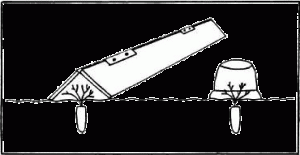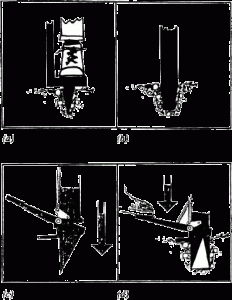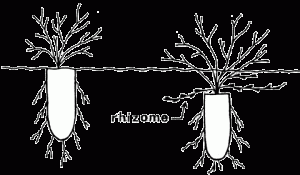221-Filling Bare Spots in Blueberry Fields
Fact Sheet No. 221, UMaine Extension No. 2057
Prepared by Tom DeGomez, Extension Blueberry Specialist and Dr. John Smagula, Professor of Horticulture, The University of Maine, Orono, ME 04469. Revised March 1990
Introduction
Lowbush blueberry fields occur on a wide variety of acidic soils. Blueberries can be found growing wild in succession forests throughout New England and Atlantic Canada. Today’s commercial fields were forests before human intervention. Clearcutting large areas started a natural movement, or succession, of plants into cleared areas. Lowbush blueberries are quick to move into clearings. However, they’re also easily dominated by faster growing species, unless humans intercede and impose management practices that safeguard lowbush blueberries as the dominant species. Blueberries may dominate in many areas, but complete coverage of a field is rare.
Blueberry plants most often increase in number through seed dispersal. They spread and cover an area by sending out underground stems (rhizomes). Fields in production before the 20th century were not managed as intensively as fields are today. Biennial pruning with fire and herbicide application were not common until the 1900s. Fire pruning increases the vigor of aerial portions of existing plants but may hinder rhizome development and spread; it may also kill young seedlings before rhizomes have a chance to develop. Fire pruning of young seedlings in a research plot at Blueberry Hill Farm in Jonesboro caused severe damage and high mortality. Recent studies at the University of Maine have shown that blueberries spread very slowly into bare spots in commercial fields. The slow movement of blueberries into bare spots suggests that current management practices hinder spread and that spreading slows as plants age.
Blueberry fields vary in plant cover from a few clones dotting a field to plants in all but a few spots. Fields that have been in production the longest have the greatest amount of cover. Young fields are poorly covered, with some areas between clones occupied by weeds or bare soil (after herbicides have killed the weeds). However, this bare area will soon be infested with a new generation of weeds. Recent studies suggest that not all clones spread at the same rate. Some fields may indeed have a greater potential to fill in naturally. However, even fields with clones that spread faster than average will take decades to approach complete plant cover.
Several problems occur when fields have poor plant cover:
- First, inputs such as pruning and chemical pest controls are unnecessarily applied to portions of the field not covered with blueberries
- Second, when herbicides are used, bare spots occur on slopes and are subject to erosion
- Third, yield potential is lower on fields with incomplete plant cover
Since clonal spread is so slow, the quickest way to increase coverage is to plant blueberries in the bare spots. This can be accomplished with plants propagated by seed, tissue culture, cuttings or blueberry sod plugs. If interplanted blueberries are managed properly, bare spots can be completely filled in and fields in full production within six years. However, this method is costly and may not be economically feasible. An alternative method to improve rhizome spread and reduce erosion is to apply surface mulch to bare areas.
Both of these techniques will be covered in this fact sheet. Management of new plantings includes mulching, fertilization, pruning, and pest control. Using mulches alone involves selection of the proper mulch for the proposed effect.
Establishing New Plantings
Plant Material
Seedlings
Planting seedlings is probably the least expensive method of propagating lowbush blueberries. Seeds are sprouted in flats and transplanted into cell‑packs where they are grown under greenhouse conditions for 18 months to 2 years. Cell‑pack culture produces individual plants that can be planted with a low‑cost tree-planter. Seedlings produce vigorous plants that develop rhizomes readily and spread rapidly. Each seedling is a different clone or variety, and therefore, date of ripening and potential yield can be quite variable, as is the case in existing blueberry fields. Seedlings from specific crosses will be less variable than from open‑pollinated crosses in which only one parent is known.
Cuttings
Cuttings taken in late June and rooted in propagation beds can be ready for planting after two growing seasons. Cuttings produce uniform plants and yields comparable to the mother plant. They have an upright growth habit with less consistent rhizome development than seedlings. Therefore, it will take longer to fill in bare spots using cuttings. Cuttings may be best suited to row culture.
Tissue Culture
Tissue culture plants may be more expensive to produce than seedlings, but they offer many advantages. These plants have been “cloned” in test tubes and therefore have a yield potential equal to that of the mother plant. Since they have been grown under sterile conditions, they should have no obvious fungal or bacterial diseases. Studies at the University of Maine indicate that tissue‑propagated plants have many seedling‑like characteristics such as smaller leaves, more vegetative buds along stems, and a high degree of branching at the plant’s base. In field tests, they produce rhizomes rapidly and more consistently than rooted cuttings do.
Sod
Blueberry sod may be dug from neighboring plants in the spring and planted into bare spots. Sod is readily available and may be dug with a shovel or golf‑hole cutter. However, digging, transporting, and planting is strenuous. Sod will produce yields equal to the mother plant. Since it already has rhizomes, it should aid in lateral spread. The holes that result from digging sod should be filled with sand and peat moss to encourage filling back in.
Site Preparation
Weed Control
Preparation of the planting site is very important. The field should be in the vegetative year (burn cycle). Weeds should be controlled in the spring by hand pulling or with a herbicide such as hexazinone (Velpar®). If bunchberry (Cornus canadensis) is growing in the area, glyphosate (Roundup®) can be used for control. Kill bunchberry with glyphosate in late summer the year before plants are established. Be careful to wipe the glyphosate only on the weeds within the area to be planted. Glyphosate will also kill blueberries.
Note: Trade names are used for identification. No product endorsement is implied, nor is discrimination intended against similar materials. For additional information on weed control refer to Wild Blueberry Fact Sheets found in the Lowbush Blueberry Growers Guide or at your local county Extension office.
Research at the University of Maine has shown that fertilizer speeds the establishment of young blueberry plants. Fertilizer applications increase vegetative growth, rhizome production, and ground cover. Response seems greatest the first two or three years after planting. Where little organic pad remains, a slow‑release type of fertilizer may be beneficial. Experiments at Blueberry Hill Farm on a plowed soil without an organic pad showed a dramatic response to frequent, multiple applications of liquid fertilizer. Preliminary results of an experiment comparing slow‑release fertilizers to multiple applications of liquid fertilizer favor the less labor intensive, slow-release fertilizers.
Fertilizer should be applied to the soil surface before mulching and planting and to the mulched surface in the spring of the second and third year. Determine fertilizer requirements after the third year by leaf analysis.
The rate and type of fertilizers that produced the greatest seedling growth and yield at Blueberry Hill Farm are one pound of Osmocote three‑month formulation (18-6-12) per 80 square feet or one pound of Peters Slow Release (14-7-7) per 60 square feet. Other slow-release fertilizers of similar formulations (N-P-K) may be as effective. Since yield is related to area covered (stem density), the cost of the fertilizer may be returned in earlier increased yields.
Mulch
Mulch seems critical for early establishment and will benefit young plants in many ways, including:
- protection from frost heaving
- suppression of weed growth
- increased rhizome growth and development
- reduced summer soil temperatures
- reduced water loss at the soil surface
- prevention of soil erosion

Apply mulch before planting if you plan to use a tree planter. Otherwise, mulch may be applied after planting. Apply mulch two to four inches deep. (One cubic yard per 90 square feet equals a depth of four inches.) The amount of mulch needed will depend on the depth of the organic pad at each site. Two inches may be applied to areas with an organic pad. When mulching after planting, cover the plants temporarily to avoid injury. Two 1-inch x 6-inch boards hinged together (Figure 1) may be used to cover several plants at a time, or plants may be covered individually using overturned plastic flower pots or drinking cups. After removing the temporary plant‑protection device, mulch should be carefully raked around the plants, leaving the stems exposed.
Mulch may be applied by hand using snow shovels or wide hay forks. For large areas, mulch may be applied mechanically with a tractor‑mounted bucket loader or a manure spreader that has had the paddle chain disconnected; this allows the mulch to fall off the end of the spreader rather than thrown to the sides.
Suitable mulches include sawdust, bark, cedar hair, wood chips, and peat. A study at Blueberry Hill Farm comparing these mulches indicated that seedling growth was comparable in all mulches except the coarser wood chips, which produced inferior growth. Reapplication may be unnecessary since these mulches are long-lasting. Mulch may be obtained at little or no cost, but transportation is expensive. Try to find a nearby source. Sawdust is the least stable of the mulches as it is subject to erosion by wind and water. Weed-free hay or straw may also be used but will decompose quickly and must be reapplied every fall.
Planting

Blueberries should be planted in the spring as soon as the ground allows and before the plants break dormancy. If the plants have broken dormancy and leaves are forming at the time of planting, low temperatures will cause the plants to go into shock. If leaves have turned red and growth has stopped, the plants are in shock. Early summer planting can be successful with adequate rainfall or available irrigation.
Plants should be kept moist before planting. If the soil is dry at planting time, add water. It will ensure proper growth and rapid establishment even if abnormally dry conditions follow planting.
Cell-pack culture produces individualized plants that are easy to transport and handle. Most cell-pack containers have ridges to prevent spiraled root growth that could girdle the plant even after field planting. Roots are air pruned when they grow out the bottom of the cell, which results in root branching and a tight root ball that lends itself to planting with tree-planters (Figure 2).
Tree-planters may be used to set plants at a depth of two to three inches below the plant’s crown so that the basal vegetative buds are buried. Deep planting encourages rhizome production from buried buds and reduces fall and spring frost heaving (Figure 3). After planting with the tube, compress the soil around the roots to ensure good root-soil contact. To accomplish this, push a shovel in next to the plant and rock back and forth on the shovel handle several times.
Spacing plants about two feet from each other in all directions should result in complete coverage in six years. An area 20 x 30 feet will require 150 plants or sod pieces. When transplanting pieces of sod with a shovel or golf‑hole cutter, plant the sod only slightly below the original depth, with spacing based on the size of the sod pieces. A five-inch plug made by the golf‑hole cutter could be spaced and mulched similarly to a seedling.
Maintenance

Weeds, diseases, and insects can be controlled in the interplanted areas in the same manner as the rest of the field. If the area has been planted with tissue‑culture plants or cuttings of only one clone, and if the area is over 2,000 square feet, there may be an increase in the incidence of a disease to which this clone is susceptible. Since pruning with fire will not be possible until the sixth year, it may be necessary to use fungicides in the interplanted areas. Using many different clones in a large interplanting will help decrease disease problems and is a good alternative to chemical control.
Pruning
To allow for maximum vegetative and rhizome growth, the plants should be allowed to grow without pruning for four years. At the end of the second cycle, the plants will have reached maturity and can be mechanically pruned with a mower or hand clippers and managed with the rest of the field.
Harvesting
If young plants are not allowed to bear fruit during the first four years, they may produce more vegetative growth and spread faster. Removal of fruit buds or flowers in the spring is the most effective way to keep the plant from fruiting, but this may not be practical. Quantities of fruit produced in the third, fourth and fifth years may be substantial and warrant careful raking or hand picking for the fresh market. By the sixth year, the plantings should be mature and bearing large quantities of fruit. Take care when harvesting to ensure that the rhizomes of the newly developed plants are not pulled out by the rake.
Information in this publication is provided purely for educational purposes. No responsibility is assumed for any problems associated with the use of products or services mentioned. No endorsement of products or companies is intended, nor is criticism of unnamed products or companies implied.
© 1990
Call 800.287.0274 (in Maine), or 207.581.3188, for information on publications and program offerings from University of Maine Cooperative Extension, or visit extension.umaine.edu.
The University of Maine is an EEO/AA employer, and does not discriminate on the grounds of race, color, religion, sex, sexual orientation, transgender status, gender expression, national origin, citizenship status, age, disability, genetic information or veteran’s status in employment, education, and all other programs and activities. The following person has been designated to handle inquiries regarding non-discrimination policies: Director of Equal Opportunity, 101 Boudreau Hall, University of Maine, Orono, ME 04469-5754, 207.581.1226, TTY 711 (Maine Relay System).
